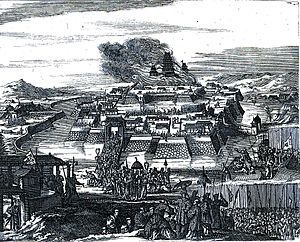Osaka Summer Campaign
| Siege of Osaka | |||||||
|---|---|---|---|---|---|---|---|
| Part of the early Edo period | |||||||
 Illustration from François Caron's book: "The Burning of Osaka Castle" |
|||||||
|
|||||||
| Belligerents | |||||||
| Tokugawa shogunate | Toyotomi clan | ||||||
| Commanders and leaders | |||||||
|
Tokugawa Ieyasu Tokugawa Hidetada Todo Takatora Ii Naotaka Matsudaira Tadanao Date Masamune Honda Tadatomo † Asano Nagaakira |
Yodo-dono † Toyotomi Hideyori † Sanada Yukimura † Gotō Mototsugu † Akashi Takenori Chōsokabe Morichika Mōri Katsunaga † Kimura Shigenari † Ōno Harunaga † |
||||||
| Strength | |||||||
| 164,000 (winter) 150,000 (summer) |
120,000 (winter) 60,000 (summer) |
||||||
| Casualties and losses | |||||||
| Minimal | Thousands killed | ||||||
The Siege of Osaka (大坂の役 Ōsaka no Eki?, or, more commonly, 大坂の陣 Ōsaka no Jin) was a series of battles undertaken by the Tokugawa shogunate against the Toyotomi clan, and ending in that clan's destruction. Divided into two stages (Winter Campaign and Summer Campaign), and lasting from 1614 to 1615, the siege put an end to the last major armed opposition to the shogunate's establishment. The end of the conflict is sometimes called the Genna Armistice (元和偃武 Genna Enbu?), because the era name was changed from Keichō to Genna immediately following the siege.
When Toyotomi Hideyoshi died in 1598, Japan came to be governed by the Council of Five Elders, among whom Tokugawa Ieyasu possessed the most authority. After defeating Ishida Mitsunari in the battle of Sekigahara in 1600, Ieyasu essentially seized control of Japan for himself, and abolished the Council. In 1603, the Tokugawa shogunate was established, with its capital at Edo. Ieyasu sought to establish a powerful and stable regime under the rule of his own clan; only the Toyotomi, led by Hideyoshi's son Toyotomi Hideyori and based at Osaka, remained an obstacle to that goal.
...
Wikipedia
